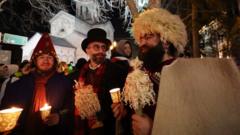In many parts of the world, Orthodox Christians continue to celebrate Christmas through heartfelt traditions and gatherings. While the majority of Christians observe this festive occasion on 25 December, approximately 200 million Orthodox Christians adhere to the Julian calendar, commemorating Christmas on 7 January. This divergence in dates is rooted in historical and cultural factors that shape their religious practices.
In Damascus, Syria, as many Christians embrace their first Christmas since the downfall of former President Bashar al-Assad, attendees embraced the warmth of community at the Armenian Apostolic Church of Mar Sarkis, receiving Holy Communion in a profound spiritual gathering. The situation in Syria adds a layer of significance to this year’s celebrations as Christians reflect on their resilience and faith amidst recent turmoil.
Further afield, Egypt's Archangel Michael Coptic Orthodox Church in Cairo hosted a festive observance led by a priest from the region’s largest Christian community, emphasizing the role of faith as a source of strength in challenging times. In Sharjah, United Arab Emirates, young worshippers brought light to the occasion by lighting candles during their Christmas Eve celebrations.
In contrast, worshippers in Bethlehem, on the West Bank, gathered at the Church of the Nativity, believed to be Jesus’s birthplace. The church buzzed with reverence as crowds celebrated the significance of the site within the Christian faith. Ethiopian Christians at Addis Ababa’s Bole Medhanialem Church illuminated the night with candles and hymns, showcasing a shared dedication to their traditions.
Russia's celebrations saw President Vladimir Putin partake in observances at St George's Church in Moscow, reinforcing the unity and tradition of Russian Orthodoxy during this important time. The streets of Moscow adorned with festive decorations echoed the joy and spirituality of the season.
Belgrade's Prince Philip participated in a traditional ceremony wielding a burning oak branch, known as badnjak, symbolizing harvest and prosperity. Meanwhile, joyous crowds in the Armenian capital of Yerevan filled the St Gregory the Illuminator Cathedral, and Georgian Christians lit candles in Tbilisi, demonstrating the rich tapestry of Orthodox Christmas celebrations across different nations and cultures.
These congregations, ceremonies, and traditions reflect the deep-rooted faith and unity among Orthodox Christians, showcasing their ability to both celebrate their past and embrace the future.
In Damascus, Syria, as many Christians embrace their first Christmas since the downfall of former President Bashar al-Assad, attendees embraced the warmth of community at the Armenian Apostolic Church of Mar Sarkis, receiving Holy Communion in a profound spiritual gathering. The situation in Syria adds a layer of significance to this year’s celebrations as Christians reflect on their resilience and faith amidst recent turmoil.
Further afield, Egypt's Archangel Michael Coptic Orthodox Church in Cairo hosted a festive observance led by a priest from the region’s largest Christian community, emphasizing the role of faith as a source of strength in challenging times. In Sharjah, United Arab Emirates, young worshippers brought light to the occasion by lighting candles during their Christmas Eve celebrations.
In contrast, worshippers in Bethlehem, on the West Bank, gathered at the Church of the Nativity, believed to be Jesus’s birthplace. The church buzzed with reverence as crowds celebrated the significance of the site within the Christian faith. Ethiopian Christians at Addis Ababa’s Bole Medhanialem Church illuminated the night with candles and hymns, showcasing a shared dedication to their traditions.
Russia's celebrations saw President Vladimir Putin partake in observances at St George's Church in Moscow, reinforcing the unity and tradition of Russian Orthodoxy during this important time. The streets of Moscow adorned with festive decorations echoed the joy and spirituality of the season.
Belgrade's Prince Philip participated in a traditional ceremony wielding a burning oak branch, known as badnjak, symbolizing harvest and prosperity. Meanwhile, joyous crowds in the Armenian capital of Yerevan filled the St Gregory the Illuminator Cathedral, and Georgian Christians lit candles in Tbilisi, demonstrating the rich tapestry of Orthodox Christmas celebrations across different nations and cultures.
These congregations, ceremonies, and traditions reflect the deep-rooted faith and unity among Orthodox Christians, showcasing their ability to both celebrate their past and embrace the future.























